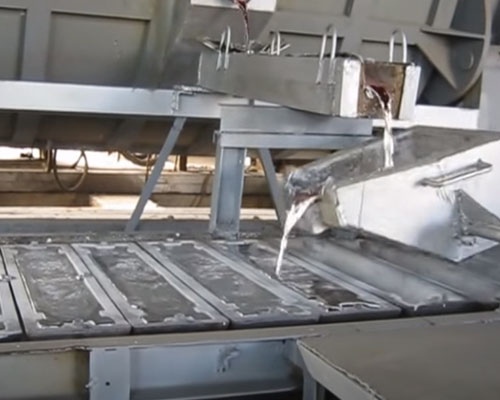Aluminum alloy casting process parameters mainly include casting temperature, casting speed, cooling intensity, followed by liquid level height, hot top casting accessories, etc. AdTech specializes in aluminum alloy foundries to provide purification equipment and hot top casting accessories to solve problems for them.
Aluminum Alloy Casting Process
Casting Temperature
At present, most of the Aluminum Alloy Casting Process has applied online degassing system and filtering devices. Practice has proved that different liquid temperatures in the online degassing device have different degassing effects. Therefore, it is necessary to consider the liquid temperature requirements of the degassing effect of the online degassing device. In addition, the gas evolution of the liquid in the crystallizer should also be considered. Due to the low casting temperature, the gas in the crystallizer is too late to float out of the liquid surface, causing porosity and looseness, and may also cause quality defects such as slag and cold insulation. The high casting temperature should not exceed the melting temperature. Too high a casting temperature will cause aluminum leakage at the beginning of casting. Because the length of the transfer tool is different and the temperature drop of the liquid is different, there is a heating point on the line, and the temperature of the liquid fluctuates greatly during the transfer process. Therefore, the casting temperature should refer to the temperature of the liquid injected into the crystallizer. Generally, the casting temperature is 50 ° C to 70 ° C higher than the actual crystallization temperature of the alloy. The transition zone of the 1xxx and 3xxx series aluminum alloys in the casting machine is narrow, and the casting temperature should be high. The transition zone of 2xxx and 7xxx series alloys is wider. The casting temperature should below.

Casting Speed
In continuous casting, the length of the ingot formed per unit time is called the casting speed. Old-style casting is usually a casting order for a fixed casting speed. Modern casting is a curve casting speed, that is, the casting start and casting process are not the same casting speed. The fast and slow casting speed has a great influence on ingot cracks, ingot surface quality, ingot structure and performance. On the premise of ensuring the quality of the ingot, a high casting speed should be used. The modern casting method adopts the curve ingot speed, which replaces the old-fashioned casting bottoming or tempering process. It not only reduces some auxiliary facilities, but also saves manpower and labor intensity, and can also avoid some casting surface quality defects. The choice of casting speed. Generally, the specifications of alloys and ingots with a greater tendency to cold cracks should increase the casting speed. For alloys and ingots with large thermal cracking tendency, the casting speed should be reduced.
Cooling Strength
The cooling intensity is also called cooling rate. The cooling intensity not only affects the cracks of the ingot, but also has a greater influence on the structure of the ingot. As the cooling intensity increases, the ingot crystallization speed increases, the intragranular structure is more refined, and the ingot liquid cavity becomes shallower. The size of the transition zone is reduced, which improves the metal packing conditions and reduces or eliminates defects such as looseness and porosity in the ingot. The density of the ingot is increased, and the size of the primary compound can be refined to reduce the degree of regional segregation.
With the development of casting technology, the crystallizer of modern casting method is integrated. When casting with an old crystallizer, the cooling water consumption is large, which inevitably produces some quality defects of the ingot. And when casting with modern crystallizer. The cooling water consumption is small. Practice has proved that it is only about 70% of the water consumption of the old crystallizer. At present, most foreign countries use low-liquid crystallizer casting, the purpose of which is to increase the cooling strength and reduce or eliminate the heating phenomenon of the air gap area after primary cooling, so there is almost no secondary cooling quenching situation, and flat casting ingots are generally cast.
The requirement of cold flushing strength on the temperature of cooling water cannot be ignored. Normally, the cooling water temperature is set at 20, but due to regional climate conditions. Differences in water supply facility conditions and plant temperature have caused large changes, resulting in regional or seasonal ingot quality defects. The modern crystallizer water supply system has the function of pulse or cross-phase transformation, which is determined by process programming, so the cooling intensity can be set as a curve according to the needs of the casting process.

